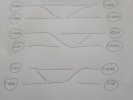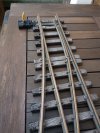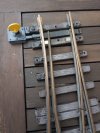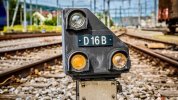You are using an out of date browser. It may not display this or other websites correctly.
You should upgrade or use an alternative browser.
You should upgrade or use an alternative browser.
Signalling Question
- Thread starter GAP
- Start date
playmofire
Registered
Ah, yes, but there is the sign indicating that the signal applies to entry to the crossing.Interesting idea, but sadly that is not signaling practice Arm straight means danger do not proceed. Of course if Rule 1 were to be invoked……
Gizzy
A gentleman, a scholar, and a railway modeller....
On my previous layout at my old home, I modified a Bachmann 4 aspect colour light signal, arranging the aspects in a square.
Lower aspects were red and amber, upper aspects were amber and green.
Thus, I had stop and proceed aspects with the diagonally arranged amber aspects indicating that the point ahead was set to diverge.
I linked these to Typ2 switches on my point motors, and it worked well for me....
Lower aspects were red and amber, upper aspects were amber and green.
Thus, I had stop and proceed aspects with the diagonally arranged amber aspects indicating that the point ahead was set to diverge.
I linked these to Typ2 switches on my point motors, and it worked well for me....
Not sure if like me you have regular and occasional visitors to your railway for operating sessions, but one thing to be careful of if you do is that you explain carefully the working of the signals that apply to your line.Looks like I am going to have to invoke Rule 1.
The scenario will be that the railway exists in a secluded valley and long ago the owners did a deal with the rail regulator that as their railway was unique they would write their own signalling rules and have them approved by the regulator. Local regulations so to speak.
That works for me.
As the signals are really a visual of the point setting I may be able to get away with just the single arm with green as horizontal and yellow and crossover. On a mimic board the colours for the points are blue=main line and orange=crossover.
Thanks for all the suggestions I may have a change yet and put 2 signals one after the other to get it right who knows. Never say never.
GAP
G Scale Model Trains, 1:1 Sugar Cane Trains
No visitors just meNot sure if like me you have regular and occasional visitors to your railway for operating sessions, but one thing to be careful of if you do is that you explain carefully the working of the signals that apply to your line.
GAP
G Scale Model Trains, 1:1 Sugar Cane Trains
Yeah that would work but I am being lazy and driving my servo of a controller set to have 2 positions to drive the points with a spare output that I was going to use.If you drive the servos properly (variable width pulse) there is no reason you can't have three positions.
You would need to be sure the servos you are going to use will allow 180° of travel, but most do. - Even the 'SG90' clones.
PhilP.
If I go for seperate control I will definitely use something that produces 3 outputs, picaxe driven by 3 position switch maybe.
Software Tools
Registered
duncan1_9_8_4
UK Railway Signaller and Garden Railway Operator
Only just found this thread. I love railway signalling, its my job, and sort of sad hobby 
For ease, though, if your points have motors, could you not use these LGB indicators, I guess you could adapt the display a little....
 www.lgb.com
www.lgb.com
For ease, though, if your points have motors, could you not use these LGB indicators, I guess you could adapt the display a little....
Lighted Turnout Lantern | LGB Websites
This working turnout lantern indicates in which direction your turnout is set. It can be installed on all LGB electric turnouts and on the LGB turnout mech
JimmyB
Now retired - trains and fishing
I use them, I also have similar items for my Piko point motors, very handy for seeing at a distance how the points are set.Only just found this thread. I love railway signalling, its my job, and sort of sad hobby
For ease, though, if your points have motors, could you not use these LGB indicators, I guess you could adapt the display a little....
Lighted Turnout Lantern | LGB Websites
This working turnout lantern indicates in which direction your turnout is set. It can be installed on all LGB electric turnouts and on the LGB turnout mechwww.lgb.com
duncan1_9_8_4
UK Railway Signaller and Garden Railway Operator
Yes, this thread prompted me, I've got a few places that I could benefit from these.I use them, I also have similar items for my Piko point motors, very handy for seeing at a distance how the points are set.
AlanL
Registered
If you had a signal at each approach to the junction (both crossovers) it would meet your needs.
So you would have 4 semaphores in total. If you control the junction as 1 crossover the 4 signals will show the route settings.
1- Both lines straight - All signals will be clear
2 - Crossover left to right - Signal on the left line will be clear and the signal on the right line will be showing stop.
3 - Crossover right to left - Signal on the right line will be clear and the signal on the left line will be showing stop.
4 - Both crossovers set - All signals will be at stop.
This applies to trains approaching from both (either) directions.
If you are driving a train and see that both signals are clear, you will know that the route is set for straight.
If you see that 1 of the signals is at stop you will know that the crossover is active and if you are on the line with a clear signal you will know that your route is set for the crossover.
It may not be prototypical but it's your railway and your drivers will know the line.
As far as speed restrictions for crossovers, I don't suppose you have any high speed trafic on your line

If you wanted a speed warning of a diverging point you could use some of these -


Simple mechanical 3D printed point indicator.
Alan
So you would have 4 semaphores in total. If you control the junction as 1 crossover the 4 signals will show the route settings.
1- Both lines straight - All signals will be clear
2 - Crossover left to right - Signal on the left line will be clear and the signal on the right line will be showing stop.
3 - Crossover right to left - Signal on the right line will be clear and the signal on the left line will be showing stop.
4 - Both crossovers set - All signals will be at stop.
This applies to trains approaching from both (either) directions.
If you are driving a train and see that both signals are clear, you will know that the route is set for straight.
If you see that 1 of the signals is at stop you will know that the crossover is active and if you are on the line with a clear signal you will know that your route is set for the crossover.
It may not be prototypical but it's your railway and your drivers will know the line.
As far as speed restrictions for crossovers, I don't suppose you have any high speed trafic on your line

If you wanted a speed warning of a diverging point you could use some of these -


Simple mechanical 3D printed point indicator.
Alan
JimmyB
Now retired - trains and fishing
Okay if you have a 3D printer.If you wanted a speed warning of a diverging point you could use some of these -
Simple mechanical 3D printed point indicator.
Alan
GAP
G Scale Model Trains, 1:1 Sugar Cane Trains
I did consider this at one stage but really like the look of semaphore signals and I have stl files to print them, thanks Alan.

 www.thingiverse.com
www.thingiverse.com
I'm using these

 www.thingiverse.com
www.thingiverse.com
I'm using the controllers in here and as they have 3 outputs I was just going to add a signal to the unused output. As I only have 2 spare outputs, I'm driving 2 point motors of one controller, that would not work due to lack of outputs unless I can parallel up servos. Bit of extra wiring but maybe possible I could probably use a picaxe to split the signal.
Bit of food for thought in all the answers so far
Points motor for Piko/LGB G Scale by dagnall53
Small 2021 update: "MG90" .stl is a set of all the parts needed for the driver. Including 4 small variations in Hex hole size for the drive gear. They work for me with TY-9018MG (metal gear) servos. This is a redesign of my "Improved points".It moves the drive rack from above" to "under" the...
I'm using these

Points Motor for G Scale with Spring by dagnall53
I was concerned that my previous rack and pinion points drive designs needed precision servo setting to avoid straining parts.Also, accidental train traffic "against" the points can derail trains or damage the drives.So this design includes springs that allow the points move in a similar way to...
I'm using the controllers in here and as they have 3 outputs I was just going to add a signal to the unused output. As I only have 2 spare outputs, I'm driving 2 point motors of one controller, that would not work due to lack of outputs unless I can parallel up servos. Bit of extra wiring but maybe possible I could probably use a picaxe to split the signal.
Bit of food for thought in all the answers so far
Interesting concept but has no relationship to prototype signaling. However it would work for a modeller if one is prepared to overlook that point.If you had a signal at each approach to the junction (both crossovers) it would meet your needs.
So you would have 4 semaphores in total. If you control the junction as 1 crossover the 4 signals will show the route settings.
1- Both lines straight - All signals will be clear
2 - Crossover left to right - Signal on the left line will be clear and the signal on the right line will be showing stop.
3 - Crossover right to left - Signal on the right line will be clear and the signal on the left line will be showing stop.
4 - Both crossovers set - All signals will be at stop.
This applies to trains approaching from both (either) directions.
If you are driving a train and see that both signals are clear, you will know that the route is set for straight.
If you see that 1 of the signals is at stop you will know that the crossover is active and if you are on the line with a clear signal you will know that your route is set for the crossover.
It may not be prototypical but it's your railway and your drivers will know the line.
As far as speed restrictions for crossovers, I don't suppose you have any high speed trafic on your line
View attachment 337963
If you wanted a speed warning of a diverging point you could use some of these -
View attachment 337965
View attachment 337966
Simple mechanical 3D printed point indicator.
Alan
GAP
G Scale Model Trains, 1:1 Sugar Cane Trains
OK look at this logic and comment please.
Scenario 2 signals near crossover one on each mainline, there is an arm at the top of the post (red) and one just under it (yellow).
the logic runs like this;
If both crossovers are set to main line then top arm of signal 1 & 2 are down, line clear
If crossover 1 is set; then signal 1 lower is down and signal 1 top is down signal 2 top is set horizontal crossover clear other mainline must stop.
if crossover 2 is set; then signal 2 lower is down and signal 2 top is down signal 1 top is set horizontal crossover clear other mainline must stop.
If both crossovers are set then both signal 1 & 2 top are set horizontal, Danger all stop
Is that workable and close to the way real signals
Scenario 2 signals near crossover one on each mainline, there is an arm at the top of the post (red) and one just under it (yellow).
the logic runs like this;
If both crossovers are set to main line then top arm of signal 1 & 2 are down, line clear
If crossover 1 is set; then signal 1 lower is down and signal 1 top is down signal 2 top is set horizontal crossover clear other mainline must stop.
if crossover 2 is set; then signal 2 lower is down and signal 2 top is down signal 1 top is set horizontal crossover clear other mainline must stop.
If both crossovers are set then both signal 1 & 2 top are set horizontal, Danger all stop
Is that workable and close to the way real signals
Nothing wrong with the logic but signals in real life do not work in that way, so ok for a rule 1 railway but we must be clear that signals are not there to show route, they are there to indicate when a section can be entered. Yes shunt signals or subsidiary signals even main signals indicate route selection, but only when pulled off, normal is for signals to show DANGER you cannot pass here.OK look at this logic and comment please.
Scenario 2 signals near crossover one on each mainline, there is an arm at the top of the post (red) and one just under it (yellow).
the logic runs like this;
If both crossovers are set to main line then top arm of signal 1 & 2 are down, line clear
If crossover 1 is set; then signal 1 lower is down and signal 1 top is down signal 2 top is set horizontal crossover clear other mainline must stop.
if crossover 2 is set; then signal 2 lower is down and signal 2 top is down signal 1 top is set horizontal crossover clear other mainline must stop.
If both crossovers are set then both signal 1 & 2 top are set horizontal, Danger all stop
Is that workable and close to the way real signals
But, bear in mind, there's a prototype for everything lInteresting concept but has no relationship to prototype signaling. However it would work for a modeller if one is prepared to overlook that point.
AlanL
Registered
If you are prepared to use 2 signals for each approach then you should use post #7 suggestion by dunnyrail because that is the most prototypical. He suggests the main signal with a second shorter signal post attatched to the side (as drawn in post #7) for the diverging route through the crosover. All signals are either stop or clear, no yellow signals. But it is your railway and you can make your own rulesScenario 2 signals near crossover one on each mainline, there is an arm at the top of the post (red) and one just under it (yellow).
AL
Software Tools
Registered
that is the most prototypical
It fact it is just one of a number of different prototypical practices and very definitely not the only one.
GAP
G Scale Model Trains, 1:1 Sugar Cane Trains
That is what I was thinking with the lower having a yellow blade something like the picture in post #16..If you are prepared to use 2 signals for each approach then you should use post #7 suggestion by dunnyrail because that is the most prototypical. He suggests the main signal with a second shorter signal post attatched to the side (as drawn in post #7) for the diverging route through the crossover. All signals are either stop or clear, no yellow signals. But it is your railway and you can make your own rules
AL
I would most likely look at my track display screen to see how the points are set but if I am outside I can also see the point setting.
I have 3d print files for a single post signal so it would be a small modification to add another arm, I hope, otherwise just 2 posts as I really don't want to redesign the 3d model.

